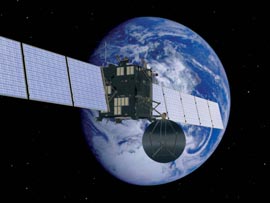
Source: ESA
Rosetta is the first mission which will escort a comet from almost aphelion to perhelion and beyond. The ESA spacecraft was launched on 2nd May 2004 by a Ariane-V rocket for a ten year circuit until arrival at 67P/Churyumov-Gerasimenko in 2014. Rosetta used several flybys at Earth and Mars to gain momentum.
Am 2. März 2004 startete die ESA-Raumsonde ihre zehnjährige Reise zum Kometen Churyumov-Gerasimenko mit einer Ariane-5 Rakete von Kourou, Französisch-Guayana. Bis zu ihrer Ankunft im Jahr 2014 hat Rosetta mehrere Vorbeiflüge an Erde und Mars genutzt (sog. „swing-bys“), um genügend Schwung zum Erreichen des Kometen zu holen. Es besteht das Ziel, den Kometen Churyumov-Gerasimenko ganz aus der Nähe zu studieren, ihn für viele Monate zu begleiten und mit einem Lander auf der Kometenoberfläche zu landen. Da sich der Komet während dieser Zeit immer näher auf die Sonne zubewegt, wird es somit erstmalig möglich sein, die Veränderungen des Kometen bei seiner Reise über mehrere Millionen Kilometer durch das All zu untersuchen. Darüber hinaus ist Rosetta auf ihrem Weg in das äußere Sonnensystem an zwei Asteroiden, Steins und Lutetia vorbeigeflogen.
Rosetta – Data
| Mission | |
|---|---|
| Launch | 2nd March 2004, 08:17 am MEZ |
| Launch site | Kourou, French Guayana |
| Launcher rocket | ARIANE 5 G |
| Duration of the mission | In total 12 years, until December 2015 |
| Mission Control Center | European Space Operations Center (ESOC), Darmstadt |
| Philae Lander Control Center | DLR MUSC, Cologne |
| ground stations | Perth (Australia), Kourou (French Guayana) |
| Start weight | 3,000 kg |
| Fuel | 1,670 kg |
| Scientific payload | 165 kg |
| Orbiter | |
|---|---|
| Dimensions orbiter | 2.8 m x 2.1 m x 2.0 m |
| Dimensions solar cell | 2 pieces, each with 14 m length, with a total plain of 64 sqm |
| Energy supply / Energy production of the solar cells | 850 W at 3,4 AU*, 395 W at 5,25 AU* |
| Communication antenna |
High gain antenna, 2,2 m diameter, rotatable |
| *AU = astronomical unit (mean distance between Earth and Sun, approx. 150 million km) | |
| Philae-Lander | |
|---|---|
| Weight | 100 kg |
| Data transfer | 16 kilobytes per second via orbiter |
| Energy supply | Solar generator, 4 W, primary (for the first 60 hours after landing on the comet) and secondary (rechargeable) batteries |
| Time schedule | |
|---|---|
| Launch | March 2004 |
| 1st Earth flyby | March 2005 |
| Mars flyby | March 2007 |
| 2nd Earth flyby | November 2007 |
| 3rd Earth flyby | November 2009 |
| Rendezvous maneuver | May 2014 |
| Global mapping of the comet | August 2014 |
| Landing on the comet | November 2014 |
| Orbit flight | August 2015 |
| End of the mission | December 2015 |
Primary objectives of the Rosetta mission:
- Investigation of the origin of the Solar System through the investigation of the composition of a comet
- The exploration of the interaction between comet material and interstellar material
- Global characterization of the comet nucleus (dynamical properties, surface morphology, composition)
- Chemical, mineralogical and isotopical composition of the volatile and solid substances of the comet nucleus
- Physical properties and correlation between the volatile and solid substances of the comet nucleus
- Investigation of the evolution of the comet activity and the processes in the crust of the nucleus and the inner coma (dust/gas interaction)
- Investigation of the general characteristics of the asteroids including the investigation of their dynamical properties, surface morphology and composition
Die ‚Orbiter‘-Nutzlast besteht aus zwölf Experimenten, deren Aufgabe es ist, den Kometenkern und die ihn umgebende Gas- und Staubwolke zu untersuchen. Die ‚Lander‘-Nutzlast bietet darüber hinaus die Möglichkeit, die Kernoberfläche und die darunterliegenden Strukturen aus unmittelbarer Nähe zu analysieren. Die obere Tabelle zeigt die Experimente des Rosetta-Orbiters und die untere Tabelle zeigt die Nutzlast des Landers.
Experiments
Remote Sensing Rosetta Lander Philae Payload For more information, visit the ESA page
| Rosetta Lander – Philae | |
|---|---|
| APX | α-particles and X-ray detector |
| Probe- drawing | – |
| COSAC | Gas analysis and elementary, molecular composition, respectively |
| MODULUS Ptolemy | Gas analysis and isotope composition |
| ÇIVA ROLIS | Rosetta lander cameras |
| SESAME | Material analysis |
| MUPUS | Material analysis |
| ROMAP | Magnetometer and plasma analysis |
| CONSERT | Tomography of the core |